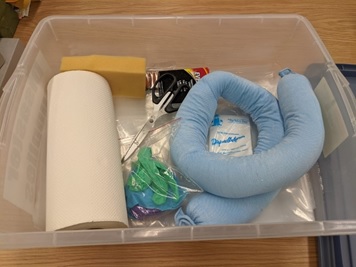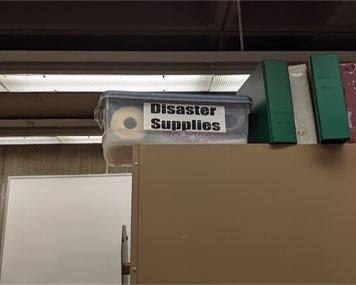Quick Tips for Disasters & Emergencies: Disaster Kits
Disaster Kits
Becky Koch, Conservation and Preservation Specialist, Milner Library, Illinois State University
In Milner Library we make an effort to be prepared for anything. This means not only having plenty of disaster response supplies, but also having them close at hand. As our building is 6 floors there is no one location that is readily accessible to every part of the library. We solve this problem by making mini “Disaster Kits” that are located on each floor of the library. Disaster kits are one quick, low cost way to make sure your library can respond to any emergency as soon as possible.
Milner Library’s mini disaster kits contain:

The inside of a disaster kit.
- Pig Socks: Cloth tubes filled with absorbent material to act as a temporary dam to keep water contained. Each kit has two socks.
- Flashlights and batteries: Two flashlights with batteries in each kit, plus an extra set of batteries.
- Plastic sheeting: Can be used to protect shelving or deflect water.
- Roll of heavy duty tape and scissors: Tape to hang the plastic sheeting and scissors to cut the tape or the plastic.
- Sponge: To help clean off muddy books or to mop up puddles.
- Plastic apron, nitrile gloves, and dust masks: Be sure to protect yourself! You don’t know what’s in dirty water; wear PPE before handling anything that may have been soaked in contaminated water or may be moldy.
- Roll of paper towels: Paper towels are always useful.
- Large plastic tub: All of this is put into a plastic tub, which can be emptied and used as a bucket if needed.
The kits are located in the staff rooms of each floor – areas that are closed off to the public but are easily accessed by any library worker. The kits are clearly labeled “Disaster Supplies” on the outside in large text, and are typically on an open shelf or on top of a cabinet.

Disaster Kits are kept in the open and are labeled clearly.
If they need to be placed inside a closed cabinet signage is put on the exterior of the cabinet that states that there is a disaster kit inside. The preservation department checks the kits two times a year to make sure they are still fully stocked, that nothing is broken or deteriorating, and that the flashlight batteries still work.
Although disaster kits are a great resource, the items in these kits alone aren’t enough to take care of an exceptional disaster. We keep extras of all of these items in a large cabinet in the main staff area of our building. The kits on each floor are only meant to provide a quick response to control the emergency until more supplies can be retrieved from the central repository.
Continue to the next article "Creating a Response Poster for Water-based Disasters"

